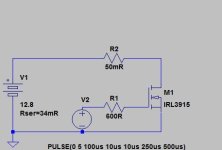Yeay! It looks like I have a small contribution for the failed components thread. I'll get the pic soon. But now I'm really puzzled about what happened :|
So... I thought, what could be more fun than shorting a big fully charged battery The battery is 12Ah, 12V SLA B&B SLA. Spec says it's 18 mOhm. Capable of 180Amps for 5 sec....
The battery is 12Ah, 12V SLA B&B SLA. Spec says it's 18 mOhm. Capable of 180Amps for 5 sec....
So I hook it up to 2 Ohm 20W resistor, IRL3103 FET, 12 awg wires. My Arduino is pulsing the FET and logging the voltage.
- First test 200ms on time for FET. No noticable drop in voltage, resistor gets warm. Current should be arround 6A
- Second test. Lower resistance to 0.5 ohm. 50ms on time for FET. Resistor gets warm. Voltage drop 1.5V. Estimated current 20A or so.. First stupid mistake. I didn't check if FET was getting hot for 20A test. I have no idea now.
- Third test. Short out resistor with 1ft long, 30awg jumper wire. I had uneasy feeling about this. But this is the prize. That's what I wanted to see!
That's where it all went wrong. I lower pulse length to 20ms, I hook it all up, Arduino sends a pulse, smoke, sparks flying! From the FET!! I was watching the jumper wire and expecting that to melt first. So post mortem is:
- I got the voltage drop recorded. It went down 3.3V, estimated current 60A or so.
- FETs fail by shorting out! Current kept on flowing until i unplugged it. Version 2 will have slow blow fuse..
Why did the FET cook? Data sheet says 12mOhm, 64A continous, 220A pulse.
- Is it because gate voltage was 5V not 10V? But this is logic level FET and is supposed to be fully on at 5V. It looks that way from the chart in the spec.
- Could it be because of gate capacitance? I have no idea how long it took to turn on.
- Because I had no heat sink?
What do I do make this work? What's the right way to drive FET gate to make sure it turns on quickly and fully?
IRF1324S just came in the mail too... I'm willing to risk this precious jewel too if that's what it takes... 0.8 mOhms, 430A continous, 1640A pulsed
So... I thought, what could be more fun than shorting a big fully charged battery
So I hook it up to 2 Ohm 20W resistor, IRL3103 FET, 12 awg wires. My Arduino is pulsing the FET and logging the voltage.
- First test 200ms on time for FET. No noticable drop in voltage, resistor gets warm. Current should be arround 6A
- Second test. Lower resistance to 0.5 ohm. 50ms on time for FET. Resistor gets warm. Voltage drop 1.5V. Estimated current 20A or so.. First stupid mistake. I didn't check if FET was getting hot for 20A test. I have no idea now.
- Third test. Short out resistor with 1ft long, 30awg jumper wire. I had uneasy feeling about this. But this is the prize. That's what I wanted to see!
That's where it all went wrong. I lower pulse length to 20ms, I hook it all up, Arduino sends a pulse, smoke, sparks flying! From the FET!! I was watching the jumper wire and expecting that to melt first. So post mortem is:
- I got the voltage drop recorded. It went down 3.3V, estimated current 60A or so.
- FETs fail by shorting out! Current kept on flowing until i unplugged it. Version 2 will have slow blow fuse..
Why did the FET cook? Data sheet says 12mOhm, 64A continous, 220A pulse.
- Is it because gate voltage was 5V not 10V? But this is logic level FET and is supposed to be fully on at 5V. It looks that way from the chart in the spec.
- Could it be because of gate capacitance? I have no idea how long it took to turn on.
- Because I had no heat sink?
What do I do make this work? What's the right way to drive FET gate to make sure it turns on quickly and fully?
IRF1324S just came in the mail too... I'm willing to risk this precious jewel too if that's what it takes... 0.8 mOhms, 430A continous, 1640A pulsed



